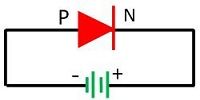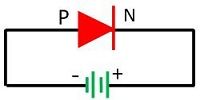Difference Between Forward & Reverse Biasing
正向偏置和反向偏置的区别
One of the major difference between the forward and the reverse biasing is that in forward biasing the positive terminal of the battery is connected to the p-type semiconductor material and the negative terminal is connected to the n-type semiconductor material. Whereas in reverse bias the n-type material is connected to the positive terminal of the supply and the p-type material is connected to the negative terminal of the battery.
正向和反向偏压的一个主要区别是,在正向偏压中,电池的正极与p型半导体材料相连,负极与n型半导体材料相连。而在反向偏压中,n型材料连接到电源的正极,p型材料连接到电池的负极。
什么是偏置?
Biasing means the electrical supply or potential difference is connected to the semiconductor device. The potential difference is of two types namely – forward bias and the reverse bias.
偏压是指将电源或电位差连接到半导体设备上。该电位差有两种类型,即正向偏压和反向偏压。
The forward bias reduces the potential barrier of the diode and establishes the easy path for the flow of current. While in reverse bias the potential difference increases the strength of the barrier which prevents the charge carrier to move across the junction. The reverse bias provides the high resistive path to the flow of current, and hence no current flows through the circuit.
正向偏压降低了二极管的势垒,为电流的流动建立了便捷的路径。而在反向偏压下,电位差增加了势垒的强度,从而阻止了电荷载体在结上移动。反向偏压为电流的流动提供了高电阻路径,因此没有电流流过电路。
Comparison Chart
Definition of Forward Biasing
In forward biasing the external voltage is applied across the PN-junction diode. This voltage cancels the potential barrier and provides the low resistance path to the flow of current. The forward bias means the positive region is connected to the p-terminal of the supply and the negative region is connected to the n-type of the device.
在正向偏压中,外部电压被施加在PN结二极管上。这个电压消除了电位屏障,并为电流的流动提供了低电阻的路径。正向偏压意味着正区与电源的p端相连,负区与器件的n型相连。
The potential barrier voltage is very small (nearly 0.7 V for silicon and 0.3 V for germanium junction) hence very few amount of voltage is required for the complete elimination of the barrier. The complete elimination of the barrier constitutes the low resistance path for the flow of current. Thus, the current starts flowing through the junction. This current is called forward current.
势垒电压非常小(硅的势垒电压接近0.7V,锗结的势垒电压接近0.3V),因此完全消除势垒所需的电压量非常小。势垒的完全消除构成了电流流动的低电阻路径。因此,电流开始流经该结。这个电流被称为正向电流。
Definition of Reverse Biasing
In reversed bias the negative region is connected to the positive terminal of the battery and the positive region is connected to the negative terminal. The reverse potential increases the strength of the potential barrier. The potential barrier resists the flow of charge carrier across the junction. It creates a high resistive path in which no current flows through the circuit.
在反向偏压中,负区与电池的正极相连,正区与负极相连。反向电位增加了势垒的强度。势垒抵制电荷载体在结上的流动。它创造了一个高电阻路径,其中没有电流流过电路。
Key Differences between Forward and Reverse Biasing
-
The forward bias reduces the strength of the potential barrier due to which the current easily move across the junction whereas reverse bias strengthens the potential barrier and obstruct the flow of charge carrier.
-
In forward biasing the positive terminal of the battery is connected to the p-region and the negative terminal is connected to the n-type material while in reverse bias the positive terminal of the supply is connected to the n- type material and the negative terminal is connected to the p-type material of the device.
-
The forward bias set up the electric field across the potential which reduces the strength of the potential barrier whereas the reverse bias increases the strength of the potential barrier.
- Note -The potential barrier is the layer between the PN junction diode which restrict the movement of electrons across the junction.
-
In forward biasing the voltage of the anode is greater than the cathode whereas in reverse bias the voltage of the cathode is greater than the anode.
-
The forward bias has large forward current while the reverse bias has very small forward current.
- Note – The current in the diode when flow in the forward direction is called forward current.
-
The depletion layer of the diode is very thin in forward biasing and thick in reverse bias.
- Note – The depletion layer is the region around the junction in which the free charge carriers are depleted.
-
The Forward bias decreases the resistance of the diode whereas the reversed bias increases the resistance of the diode.
-
In forward biasing the current is easily flowing through the circuit whereas reverse bias does not allow the current to flow through it.
-
In forward biasing the magnitude of the current depends on the forward voltage whereas in reverse bias the magnitude of the current is very small or negligible.
-
In forward biasing the device operates as a conductor whereas in reverse bias the device act as an insulator.
-
正向偏置降低了电位势垒的强度,因此电流很容易穿过结,而反向偏置则加强了电位势垒并阻碍了电荷载流子的流动。
-
在正向偏置中,电池的正端连接到p区,负极连接到n型材料,而在反向偏置中,电源的正极连接到n型材料,负极连接到器件的p型材料。
-
正向偏置在电位上设置电场,从而降低电位势垒的强度,而反向偏置增加电位势垒的强度。
- 注意-电位势垒是PN结二极管之间的层,它限制了电子在结中的运动。
-
在正向偏置中,阳极的电压大于阴极,而在反向偏置中,阴极的电压大于阳极。
-
正向偏置具有较大的正向电流,而反向偏置具有非常小的正向电流。
- 注意 – 二极管中沿正向方向流动时的电流称为正向电流。
-
二极管的耗尽层在正向偏置时非常薄,在反向偏置时很厚。
- 注意 – 耗尽层是离荷载流子耗尽的结周围的区域。
-
正向偏置降低二极管的电阻,而反向偏置增加二极管的电阻。
-
在正向偏置中,电流很容易流过电路,而反向偏置则不允许电流流过电路。
-
在正向偏置中,电流的大小取决于正向电压,而在反向偏置中,电流的大小非常小或可以忽略不计。
-
在正向偏置中,器件充当导体,而在反向偏置中,器件充当绝缘体。




